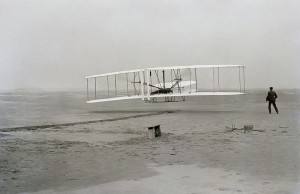Good morning.
Our week begins with cloudy skies and a high of thirty five. We’ll have 9h 2m of sunlight and 10h 6m of daylight, with tomorrow being one minute shorter.
On this day in 1903, the first success of one of the greatest inventions of all history, reported later with marked understatement in the New York Times:
The inventors of the airship which is said to have made several successful flights in North Carolina, near Kitty Hawk, are anxious to sell the use of their device to the Government. They claim that they have solved the problem of aerial navigation, and have never made a failure of any attempt to fly.
Their machine is an adaptation of the box kite idea, with a propeller working on a perpendicular shaft to raise or lower the craft, and another working on a horizontal shaft to send it forward. The machine, it is said, can be raised or lowered with perfect control, and can carry a strong gasoline engine capable of making a speed of ten miles an hour.
The test made in North Carolina will be fully reported to the Ordnance Board of the War Department, and if the machine commends itself sufficiently, further tests will be made in the vicinity of Washington, and an effort made to arrange a sale of the device to the Government. The use to which the Government would put it would be in scouting and signal work, and possibly torpedo warfare.
First successful flight of the Wright Flyer, by the Wright brothers. The machine traveled 120 ft (36.6 m) in 12 seconds at 10:35 a.m. at Kitty Hawk, North Carolina. Orville Wright was at the controls of the machine, lying prone on the lower wing with his hips in the cradle which operated the wing-warping mechanism. Wilbur Wright ran alongside to balance the machine, and just released his hold on the forward upright of the right wing in the photo. The starting rail, the wing-rest, a coil box, and other items needed for flight preparation are visible behind the machine. This was considered “the first sustained and controlled heavier-than-air, powered flight” by the Fédération Aéronautique Internationale. Via Wikipedia.
From Google-a-Day, a question about American literature, and history: “What state holds a real life contest and celebration commemorating Mark Twain’s short story about the out-of-towner and the compulsive gambler?”
